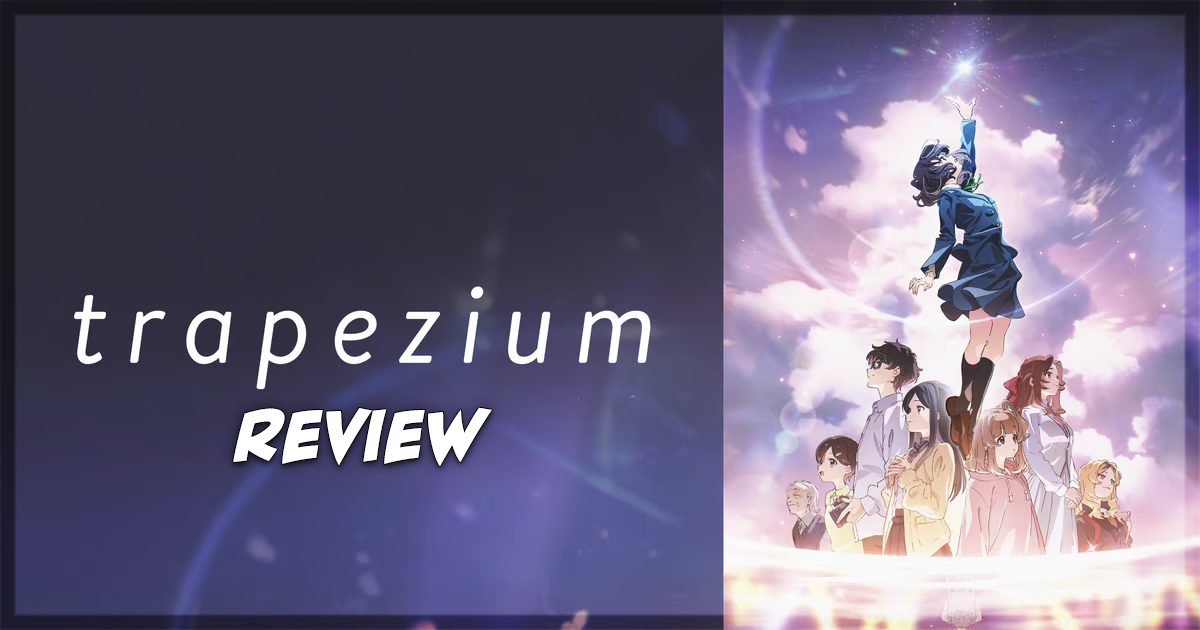From the first few frames of director Masahiro Shinohara’s anime film Trapezium, we are introduced to the hazy and glitzy fever-dream world of J-pop idol fame. This opening is a rush of purple and green and glitter, with some fantastic vocals too. As the movie progresses, we learn that it’s a daydream for our main character, high school student Yu Azuma (Asaki Yukikawa), who wants to be a famous J-pop idol. She is the vehicle for which we, the audience, enter this world of ambition and daydreams and the person we spend the most time with. Azuma has a little blue book with her plan to achieve fame, and we learn pretty early on that her plan involves gathering “stars,” otherwise known as other girls from the four high schools of her city, to form a girl band.
Azuma’s journey in Trapezium firmly establishes it as a coming-of-age film in the vein of Spirited Away. The movie doesn’t take place over many years, but there is still a reflective quality to it, and a distinct before and after for the girls Azuma has recruited in her dream. As an audience, we are gently asked to judge Azuma. Her relationships with the girls of NEWS are carefully curated and engineered into existence. Whether or not you land on the side of her being manipulative or just cunning and determined is part of the film’s central question and something the main character must eventually answer herself. At what price does fame come?
Azuma successfully recruits the other high school girls into NEWS, but does so (as you could probably guess) under false pretenses. She pretends to care about what they really care about and becomes their confidant in order to get her own dream. She selects them in her own twisted version of idol recruitment and steers them into volunteering at a castle that eventually causes them to be noticed by a TV producer.
After their big break, it’s not all roses for Azuma and the other girls of NEWS. While she is set on idol stardom no matter the troubles to get there, the other girls don’t quite have that same burning desire for fame. Trapezium shows some of the harsh reality that J-pop idols are subject to, from restrictions on their personal lives to intense training. The anime delivers a real and thoughtful look at the cost to celebrity and what it does to the mental health to those that are famous.
And what really makes this story stand out is that there is more than a grain of truth in it because of the lived experiences behind it infused within the screenplay. Trapezium is brought to the screen by screenwriter Yuko Kakihara, but it is based on a best-selling book by a former idol, Kazumi Takayama, who was a member of the group Nogizaka46. Takayama knows all too well about this high-stakes world, and Kakihara captured that experience well. The friendships and the events that lead to fame all feel grounded and like they could really have happened. (If you’re paying attention, you’ll even catch Takayama along with Nogizaka46 co-member Nanase Nishino with voice cameos as old men in Trapezium.)
The process of climbing the ladder for success and fame is not for the timid, and this story and Azuma’s journey shows that. Without spoiling the end, Azuma does satisfyingly learn a lesson, as you would expect for a film of this genre. And despite Trapezium’s brisk runtime at just over 90 minutes, the film doesn’t feel rushed, and the time is exactly the right amount of time we need for Azuma’s stars and her eventual redemption.
Outside of the story, there is a lot to like in the artistry of Trapezium. The inorganic motivations of this Azuma are in sharp contrast to the organic beauty of the film’s animation. There is something quite pretty, almost sweet, and endearing in the art on screen, even when things are going quite horribly. Cloverworks, best known as of late for their hand in Spy X Family, is the Japanese animation studio behind what we see on screen, and is really good at their craft. The color palette shifts depending on the mood on the screen, and there’s an incredible use of light and reflection. The animators, along with cinematographer Yoshihiro Sekiya are indeed skilled in their command of light and color. In this way, it is reminiscent of the recent film The Imaginary.
The bleak times in the story – where Azuma has crossed over into emotional breakdown territory – are grayer and you can feel the sadness of the world on screen. In happier times, that’s the case too. When the friendship between the girls is fresh and new and filled with promise, things are super-saturated with a brightness to them. And something as simple as a puddle reflecting the blue sky is quite gorgeous, and that’s due to the care of crafting these vistas.
In a story about J-pop and the world of idols, good music is expected. It’s practically a promise to the audience with that initial daydream that introduces us to the world. Trapezium keeps that promise. Hoshimachi Suisei, a virtual YouTuber, lends her distinctive vocals to the music of the film. It caused a stir when it was announced, and it’s quite evident why. Thematically, Suisei also fits well in the overall discussion of idol fame and authenticity. The movie’s score, from composer Masaru Yokoyama, features heavy piano that is quite evocative. Like the animation, it mirrors the moods of the story enjoyably.
Overall, Trapezium is an entertaining time at the movies. The film had a very short US theatrical window, but it’s now available to stream. It’s worth watching if you like coming-of-age stories, and especially if you are curious about the workings of the idol industry or just want an entertaining story about friendships and ambition.
Trapezium is now streaming on Crunchyroll.
Learn more about the film, including how to watch, on the Crunchyroll website.
You might also like…
‘Delicious in Dungeon’ Review: Dungeons and Dragons meets Chopped


